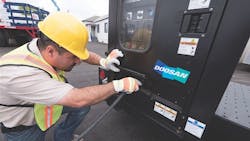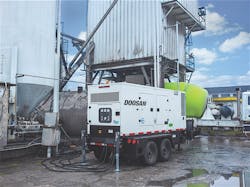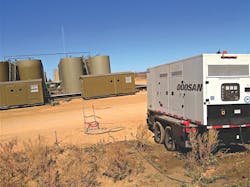Of all the equipment in a rental fleet, perhaps none is as intimidating as a generator. Knowing how to properly size a generator to fit a customer’s application is important, but not always easy. Rental companies that make the effort to understand the details required for proper sizing will provide their customers with better value and be in the best position to earn repeat business in this highly competitive market.
To properly size a generator, it’s necessary to understand how generators are rated. Most manufacturers give their products model names based on the machine’s kilovolt-ampere (kVA) rating. In the simplest terms, kVA is the generator’s voltage output multiplied by its amperage (amp) rating. However, most customers don’t specify their power needs in kVA, but rather refer in terms of kilowatts (kW) or amps. Fortunately, generator manufacturers list each of these values in their product data and on the generator’s nameplate as well. The table below shows an example for a 100 kVA generator:
|
Kilovolt-Amp Rating (kVA) |
Kilowatt Rating (kW) |
Voltage (V) |
Amperage (A) |
|
100 kVA |
80 kW |
480 V |
120 A |
|
100 kVA |
80 kW |
240 V |
240 A |
|
100 kVA |
80 kW |
208 V |
278 A |
In rental applications, the goal is not to calculate customer requirements down to the last amp. Often, the goal is to understand enough about the power needs and balance that against what generators are available in your fleet. Although generators are typically designed to operate at their published nameplate rating, it is good practice to size rental applications at 70 to 85 percent of this value. This will allow the generator to operate efficiently while also providing a reasonable amount of overhead to account for estimate errors in sizing calculations, or to provide extra power for unrealized needs.
It is also important, particularly with today’s advanced Tier 4 diesel engines, to avoid significantly oversizing a generator for an application. Not only is an oversized generator inefficient and more costly for the customer, it can also impact the rental company’s cost of ownership through increased maintenance and downtime. Operating a generator at less than 30 percent of rated output over an extended period of time can cause issues with the engine emission control systems, resulting in fault codes, shutdowns and potentially expensive repairs. For applications where periodic light load operation (less than 30 percent of rated output) cannot be avoided, rental companies should consider providing generators equipped with a load management solution.
The next step in properly sizing a generator is getting a list of the equipment being powered, the voltage the equipment operates at and how much amperage each device draws. This information is typically found on dataplates on the equipment. Keep in mind that while most mobile generators are designed to produce different voltages, there are limitations on which voltages are available simultaneously. If an application requires several different voltages, you may need to quote multiple generators or a transformer to convert the generator output to the voltage that is needed. For utility loads, such as small tools, simply add up the amperage draw for each tool and confirm the total amperage is less than the machine rating (targeting 70 to 85 percent) at the desired voltage.
If the generator is powering an electric motor, which is a very common application, additional questions must be answered. The horsepower of the motor and the startup, or inrush current, have a significant impact on selecting the right generator. The motor dataplate will list the voltage, running amperage and horsepower, but the startup current must be calculated. This can be as much as six to 10 times greater than the amperage listed on the dataplate. The type of motor starter that the application is equipped with is also a factor. Full voltage or across-the-line starters result in the greatest amount of inrush current, while VFDs and other types of “soft starters” can lessen the inrush current and help reduce the size of the generator needed for the application.
Becoming knowledgeable on generator sizing is not difficult. Most manufacturers offer product training that includes from how to utilize the features and benefits on the generator to how to provide a positive experience for customers and techniques for sizing generators for various applications. With many opportunities to receive training on generators, equipment rental suppliers should commit to training at least one sales representative on the product. The benefit to customer service and generator performance is well worth the investment in training.
Todd Howe is manager of global generator products for Doosan Portable Power.


